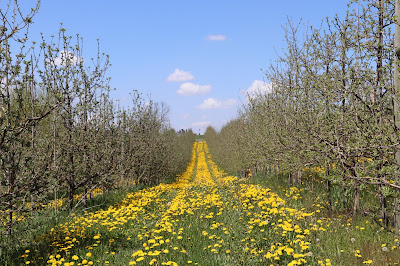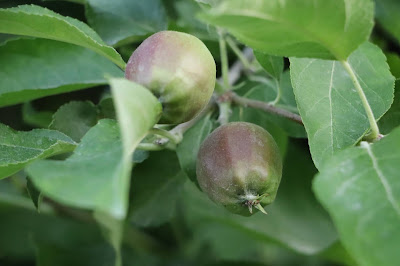If I use my imagination, I can see at the far end of the orchard where the two rows converge in this photo, a sort of heart shape that symbolizes my love of the dazzling blossom scene. Every spring I marvel at the splendor of the flowering trees lining our orchard. Although it seems rather strange to be posting orchard blossoming photos during the current apple harvest time, here we are at the beautiful budding stage in the third installment of the Orchard Days series. (See post #1 here and post #2 here)
On the apple trees in the spring, the earliest signs of life are the leaves that unfold from buds showing the tiniest amount of green tissue. After the leaves are decidedly out, the apple blossoms follow. (after the dandelion blossoms!)
When the buds of the blossoms have not yet opened up at all, they are in what is called "tight cluster". The buds in the photo above are just coming out of tight cluster and into the pink stage.
Apple blossoms come in clusters. The center flower, called "the king bloom", is typically surrounded by five blossoms. Each blossom has the potential to grow into an apple.
The king bloom opens first, and will develop into the biggest apple of the cluster.
The images above show clusters with the king blooms fully open while the outer blooms are still pink in their opening.
When more of the flowers in the clusters are open, the overall orchard color becomes white rather than the pink blush seen at the beginning of blossom season.
The fully-opened blossoms do vary in pinkishness somewhat, though, depending on what kind of apple they are.
I wonder if Anne of Green Gables would call this area of the orchard "The White Way of Delight".
Since bees are a great asset to us orchard owners, we rent hives of bees during blossom season. The color and scent of the apple blossom petals attract the bees. While the bees collect nectar from the blossoms, they brush against the flower's pollen (the male reproductive part of the plant) which sticks to stiff hairs on their bodies. They carry the pollen from one flower to another, pollenating or fertilizing the female part of the flower, which eventually produces the fruit.
Not only do the hired honeybees enjoy a sunny day in the blooming orchard, but wild bees such as this bumblebee also have a buzzing good time among the blossoms.
As the lovely flowers begin to fade, the petals detach easily, especially in wind and rain. This stage is called "petal fall". The layer of petals on the floor of the orchard can be so thick it looks like a scattering of large snowflakes.
Very soon after the petals fall off, the little apples become visible. In this photo, the king bloom apple is rising above the rest of the apples in the cluster. The stamens make up the multiple antennae feature of the flower. They, along with the calyx (those five stiff green "petals", or sepals, just under the stamens), eventually become the tiny flower-looking thing at the end of the apple opposite the stem.
Watching the tiny apples grow is a delight to a fruit farmer. The next step in his work of raising apples will be to thin the apples. In the next blog post in this Orchard Days series, I will write about the thinning and pruning that takes place in our orchard.
























Love the blossom avenue and the dandelion pathway. Beautiful!
ReplyDeleteThanks, Lucinda!
Delete